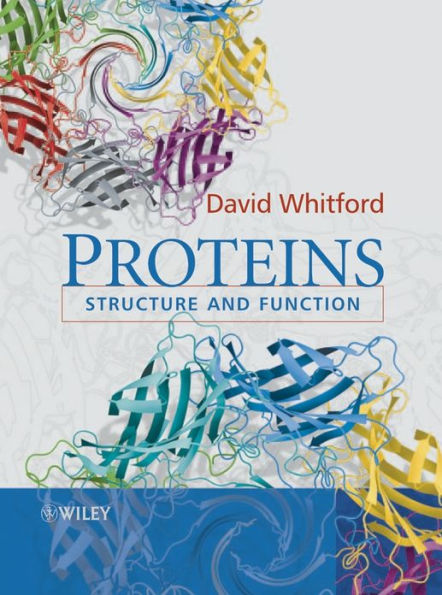Overview
The latest developments in the field are included and key concepts introduced in a user-friendly way to ensure that students are able to grasp the essentials before moving on to more advanced study and analysis of proteins.
An invaluable resource for students of Biochemistry, Molecular Biology, Medicine and Chemistry providing a modern approach to the subject of Proteins.

Product Details
| ISBN-13: | 9781118685723 |
|---|---|
| Publisher: | Wiley |
| Publication date: | 04/25/2013 |
| Sold by: | JOHN WILEY & SONS |
| Format: | eBook |
| Pages: | 544 |
| File size: | 20 MB |
| Note: | This product may take a few minutes to download. |
About the Author
Table of Contents
Preface xi1 An Introduction to protein structure and function 1
A brief and very selective historical perspective 1
The biological diversity of proteins 5
Proteins and the sequencing of the human and other genomes 9
Why study proteins? 9
2 Amino acids: the building blocks of proteins 13
The 20 amino acids found in proteins 13
The acid–base properties of amino acids 14
Stereochemical representations of amino acids 15
Peptide bonds 16
The chemical and physical properties of amino acids 23
Detection, identification and quantification of amino acids and proteins 32
Stereoisomerism 34
Non-standard amino acids 35
Summary 36
Problems 37
3 The three-dimensional structure of proteins 39
Primary structure or sequence 39
Secondary structure 39
Tertiary structure 50
Quaternary structure 62
The globin family and the role of quaternary structure in modulating activity 66
Immunoglobulins 74
Cyclic proteins 81
Summary 81
Problems 83
4 The structure and function of fibrous proteins 85
The amino acid composition and organization of fibrous proteins 85
Keratins 86
Fibroin 92
Collagen 92
Summary 102
Problems 103
5 The structure and function of membrane proteins 105
The molecular organization of membranes 105
Membrane protein topology and function seen through organization of the erythrocyte membrane 110
Bacteriorhodopsin and the discovery of seven transmembrane helices 114
The structure of the bacterial reaction centre 123
Oxygenic photosynthesis 126
Photosystem I 126
Membrane proteins based on transmembrane β barrels 128
Respiratory complexes 132
Complex III, the ubiquinol-cytochrome c oxidoreductase 132
Complex IV or cytochrome oxidase 138
The structure of ATP synthetase 144
ATPase family 152
Summary 156
Problems 159
6 The diversity of proteins 161
Prebiotic synthesis and the origins of proteins 161
Evolutionary divergence of organisms and its relationship to protein structure and function 163
Protein sequence analysis 165
Protein databases 180
Gene fusion and duplication 181
Secondary structure prediction 181
Genomics and proteomics 183
Summary 187
Problems 187
7 Enzyme kinetics, structure, function, and catalysis 189
Enzyme nomenclature 191
Enzyme co-factors 192
Chemical kinetics 192
The transition state and the action of enzymes 195
The kinetics of enzyme action 197
Catalytic mechanisms 202
Enzyme structure 209
Lysozyme 209
The serine proteases 212
Triose phosphate isomerase 215
Tyrosyl tRNA synthetase 218
EcoRI restriction endonuclease 221
Enzyme inhibition and regulation 224
Irreversible inhibition of enzyme activity 227
Allosteric regulation 231
Covalent modification 237
Isoenzymes or isozymes 241
Summary 242
Problems 244
8 Protein synthesis, processing and turnover 247
Cell cycle 247
The structure of Cdk and its role in the cell cycle 250
Cdk–cyclin complex regulation 252
DNA replication 253
Transcription 254
Eukaryotic transcription factors: variation on a ‘basic’ theme 261
The spliceosome and its role in transcription 265
Translation 266
Transfer RNA (tRNA) 267
The composition of prokaryotic and eukaryotic ribosomes 269
A structural basis for protein synthesis 272
An outline of protein synthesis 273
Antibiotics provide insight into protein synthesis 278
Affinity labelling and RNA ‘footprinting’ 279
Structural studies of the ribosome 279
Post-translational modification of proteins 287
Protein sorting or targeting 293
The nuclear pore assembly 302
Protein turnover 303
Apoptosis 310
Summary 310
Problems 312
9 Protein expression, purification and characterization 313
The isolation and characterization of proteins 313
Recombinant DNA technology and protein expression 313
Purification of proteins 318
Centrifugation 320
Solubility and ‘salting out’ and ‘salting in’ 323
Chromatography 326
Dialysis and ultrafiltration 333
Polyacrylamide gel electrophoresis 333
Mass spectrometry 340
How to purify a protein? 342
Summary 344
Problems 345
10 Physical methods of determining the three-dimensional structure of proteins 347
Introduction 347
The use of electromagnetic radiation 348
X-ray crystallography 349
Nuclear magnetic resonance spectroscopy 360
Cryoelectron microscopy 375
Neutron diffraction 379
Optical spectroscopic techniques 379
Vibrational spectroscopy 387
Raman spectroscopy 389
ESR and ENDOR 390
Summary 392
Problems 393
11 Protein folding in vivo and in vitro 395
Introduction 395
Factors determining the protein fold 395
Factors governing protein stability 403
Folding problem and Levinthal’s paradox 403
Models of protein folding 408
Amide exchange and measurement of protein folding 411
Kinetic barriers to refolding 412
In vivo protein folding 415
Membrane protein folding 422
Protein misfolding and the disease state 426
Summary 435
Problems 437
12 Protein structure and a molecular approach to medicine 439
Introduction 439
Sickle cell anaemia 441
Viruses and their impact on health as seen through structure and function 442
HIV and AIDS 443
The influenza virus 457
p53 and its role in cancer 470
Emphysema and α1-antitrypsin 475
Summary 478
Problems 479
Epilogue 481
Glossary 483
Appendices 491
Bibliography 495
References 499
Index 511

